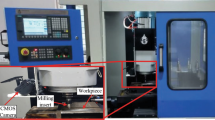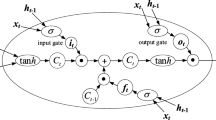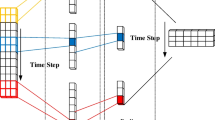Abstract
Although many efforts have been made on off-line tool wear prediction, the on-line intelligent prediction of tool wear prediction based on indeterminate factor relationship has not been addressed. In this paper, a tool wear prediction model is built based on bidirectional long short-term memory neural network (BiLSTM) to deal with these challenges. The acoustic emission (AE) signal and tool wear image are selected as indicators to characterize the wear behavior of micro-grinding tool. The BiLSTM model is constructed with the input of 4-dimensional feature vector, which is composed of medium frequency energy ratio of the AE signal, initial tool cross-sectional area, micro-grinding depth and micro-grinding length, and the output of the loss of tool cross-sectional area. Two derived models of genetic algorithm-optimized BiLSTM (GA-BiLSTM) and long short-term memory neural network (LSTM) are developed to compare the accuracy of the BiLSTM model. Two machine learning models of back propagation neural network (BP) and algorithm optimized BP neural network (GA-BP) are developed to compare the stability and superiority of the BiLSTM model. The micro-grinding experiment is conducted by the electroplated diamond micro-grinding tool to verify the feasibility using the proposed methods and the results show that the average prediction accuracy of the BiLSTM model reached 92.08% while the accuracies of other models from GA-BiLSTM to GA-BP are separately 87.2%, 88.6%, 84.4%, and 85.8%. The BiLSTM model provides a novel wear characterization and prediction method that combines AE signals and visual images using small-sample and multi-sourced heterogeneous data. It undoubtedly promotes sustainable manufacturing and provide theoretical basis for independent decision-making in precision intelligent manufacturing.











Similar content being viewed by others
Code availability
The data generated during this study are available from the corresponding author on reasonable request.
References
Li W, Ren YH, Li CF, Li ZP, Li MJ (2020) Investigation of machining and wear performance of various diamond micro-grinding tools. Int J Adv Manuf Technol 106(3-4):921–935. https://doi.org/10.1007/s00170-019-04610-4
An Q, Tao Z, Xu X, El Mansori M, Chen M (2020) A data-driven model for milling tool remaining useful life prediction with convolutional and stacked LSTM network. Measurement 154:107461. https://doi.org/10.1016/j.measurement.2019.107461
Ren Y, Li C, Li W, Li M, Liu H (2019) Study on micro-grinding quality in micro-grinding tool for single crystal silicon. J Manuf Process 42:246–256. https://doi.org/10.1016/j.jmapro.2019.04.030
Mohanraj T, Shankar S, Rajasekar R, Sakthivel NR, Pramanik A (2020) Tool condition monitoring techniques in milling process - a review. J Mater Res Technol-Jmr&T 9(1):1032–1042. https://doi.org/10.1016/j.jmrt.2019.10.031
Wu SH, Li Y, Li WG, Zhao XZ, Luo CL, Yu QL, Lin SJ (2023) A hybrid network capturing multisource feature correlations for tool remaining useful life prediction. Intal J Adv Manuf Technol 125(5-6):2815–2831. https://doi.org/10.1007/s00170-023-10837-z
Yang X, Fang Z, Yang Y, Mba D, Li X (2019) A novel multi-information fusion grey model and its application in wear trend prediction of wind turbines. Appl Math Modell 71:543–557. https://doi.org/10.1016/j.apm.2019.02.043
Gai XY, Cheng YN, Guan R, Jin YB, Lu MD (2022) Tool wear state recognition based on WOA-SVM with statistical feature fusion of multi-signal singularity. Int J Adv Manuf Technol 123(7-8):2209–2225. https://doi.org/10.1007/s00170-022-10342-9
Banda T, Farid AA, Li C, Jauw VL, Lim CS (2022) Application of machine vision for tool condition monitoring and tool performance optimization-a review. Int J Adv Manuf Technol 121(11-12):7057–7086. https://doi.org/10.1007/s00170-022-09696-x
Zhang XH, Yu HY, Li CC, Yu ZJ, Xu JK, Li YQ, Yu HD (2023) Study on in-situ tool wear detection during micro end milling based on machine vision. Micromachines 14(1). https://doi.org/10.3390/mi14010100
Qin Y, Liu X, Yue C, Zhao M, Wei X, Wang L (2023) Tool wear identification and prediction method based on stack sparse self-coding network. J Manuf Syst 68:72–84. https://doi.org/10.1016/j.jmsy.2023.02.006
Zhuo RJ, Deng ZH, Chen B, Liu GY, Bi SH (2021) Overview on development of acoustic emission monitoring technology in sawing. Int J Adv Manuf Technol 116(5-6):1411–1427. https://doi.org/10.1007/s00170-021-07559-5
Wang S, Zhao QL, Wu T (2022) An investigation of monitoring the damage mechanism in ultra-precision grinding of monocrystalline silicon based on AE signals processing. J Manuf Process 81:945–961. https://doi.org/10.1016/j.jmapro.2022.07.055
Yan BL, Zhu LD, Dun YC (2021) Tool wear monitoring of TC4 titanium alloy milling process based on multi-channel signal and time-dependent properties by using deep learning. J Manuf Syst 61:495–508. https://doi.org/10.1016/j.jmsy.2021.09.017
Hou W, Guo H, Luo L, Jin M (2022) Tool wear prediction based on domain adversarial adaptation and channel attention multiscale convolutional long short-term memory network. J Manuf Process 84:1339–1361. https://doi.org/10.1016/j.jmapro.2022.11.017
Wang J, Li Y, Zhao R, Gao RX (2020) Physics guided neural network for machining tool wear prediction. J Manuf Syst 57:298–310. https://doi.org/10.1016/j.jmsy.2020.09.005
Baydoun S, Fartas M, Fouvry S (2023) Comparison between physical and machine learning modeling to predict fretting wear volume. Tribol Int 177:107936. https://doi.org/10.1016/j.triboint.2022.107936
Li Y, Wang J, Huang Z, Gao RX (2022) Physics-informed meta learning for machining tool wear prediction. J Manuf Syst 62:17–27. https://doi.org/10.1016/j.jmsy.2021.10.013
Qiang BY, Shi KN, Liu N, Ren JX, Shi YY (2023) Integrating physics-informed recurrent Gaussian process regression into instance transfer for predicting tool wear in milling process. J Manuf Syst 68:42–55. https://doi.org/10.1016/j.jmsy.2023.02.019
Huang W, Zhang X, Wu C, Cao S, Zhou Q (2022) Tool wear prediction in ultrasonic vibration-assisted drilling of CFRP: a hybrid data-driven physics model-based framework. Tribol Int 174:107755. https://doi.org/10.1016/j.triboint.2022.107755
Zhou Y, Xue W (2018) Review of tool condition monitoring methods in milling processes. Int J Adv Manuf Technol 96(5):2509–2523. https://doi.org/10.1007/s00170-018-1768-5
Cheng M, Jiao L, Yan P, Jiang H, Wang R, Qiu T, Wang X (2022) Intelligent tool wear monitoring and multi-step prediction based on deep learning model. J Manuf Syst 62:286–300. https://doi.org/10.1016/j.jmsy.2021.12.002
Wei WH, Cong R, Li YT, Abraham AD, Yang CY, Chen ZT (2022) Prediction of tool wear based on GA-BP neural network. Proc Inst Mech Eng Part B-J Eng Manuf 236(12):1564–1573. https://doi.org/10.1177/09544054221078144
Chen SH, Lin YY (2023) Using cutting temperature and chip characteristics with neural network BP and LSTM method to predicting tool life. Int J Adv Manuf Technol 127(1-2):881–897. https://doi.org/10.1007/s00170-023-11570-3
Siami-Namini S, Tavakoli N, Namin AS (2019) The performance of LSTM and BiLSTM in forecasting time series. Paper presented at the 2019 IEEE International Conference On Big Data (Big Data)
Wu XQ, Li J, Jin YQ, Zheng SX (2020) Modeling and analysis of tool wear prediction based on SVD and BiLSTM. Int J Adv Manuf Technol 106(9-10):4391–4399. https://doi.org/10.1007/s00170-019-04916-3
Ma JY, Luo DC, Liao XP, Zhang ZK, Huang Y, Lu J (2021) Tool wear mechanism and prediction in milling TC18 titanium alloy using deep learning. Measurement 173. https://doi.org/10.1016/j.measurement.2020.108554
Pfeifer T, Wiegers L (2000) Reliable tool wear monitoring by optimized image and illumination control in machine vision. Measurement 28(3):209–218. https://doi.org/10.1016/S0263-2241(00)00014-2
Li XL (2002) A brief review: acoustic emission method for tool wear monitoring during turning. Int J Mach Tools Manuf 42(2):157–165. https://doi.org/10.1016/S0890-6955(01)00108-0
Liao TW, Ting C-F, Qu J, Blau PJ (2007) A wavelet-based methodology for grinding wheel condition monitoring. Int J Mach Tools Manuf 47(3-4):580–592. https://doi.org/10.1016/j.ijmachtools.2006.05.008
Zhang XX, Ren YH, Yang WC, Li W, Yu KN (2022) Study on acoustic emission signal perception of unsteady characteristic in micro-grinding of monocrystalline silicon. J Mech Eng 58(15):121–133
Marani M, Zeinali M, Songmene V, Mechefske CK (2021) Tool wear prediction in high-speed turning of a steel alloy using long short-term memory modelling. Measurement 177:109329. https://doi.org/10.1016/j.measurement.2021.109329
Goodfellow IBY, Courville A (2016) Deep learning. MIT Press, Cambridge,Massachusetts
Harari O, Bingham D, Dean A, Higdon D (2018) Computer experiments: prediction accuracy, sample size and model complexity revisited. Stat Sinica 28(2):899–919. https://doi.org/10.5705/ss.202016.0217
Shi J, Zhang YY, Sun YH, Cao WF, Zhou LT (2022) Tool life prediction of dicing saw based on PSO-BP neural network. Int J Adv Manuf Technol 123(11-12):4399–4412. https://doi.org/10.1007/s00170-022-10466-y
Meng X, Zhang J, Xiao G, Chen Z, Yi M, Xu C (2021) Tool wear prediction in milling based on a GSA-BP model with a multisensor fusion method. Int J Adv Manuf Technol 114(11-12):3793–3802. https://doi.org/10.1007/s00170-021-07152-w
Funding
This research is funded by National Key R&D Program of China (No. 2020YFB1713002) and National Natural Science Foundation of China (No. 52075161).
Author information
Authors and Affiliations
Contributions
Chengxi She: conceptualization, investigation, methodology, writing, review, and editing. Kexin Li: investigation, writing—review and editing, and supervision. Yinghui Ren: conceptualization, investigation, supervision, and funding. Wei Li: investigation and writing—review and editing. Kun Shao: investigation and supervision.
Corresponding author
Ethics declarations
Ethical approval
The work does not contain libelous or unlawful statements and does not infringe on the rights of others, or contains material or instructions that might cause harm or injury.
Consent to participate
All authors consent to participate.
Consent for publication
All authors agree to transfer copyright of this article to the publisher.
Conflict of interest
The authors declare no competing interests.
Additional information
Publisher’s note
Springer Nature remains neutral with regard to jurisdictional claims in published maps and institutional affiliations.
Rights and permissions
Springer Nature or its licensor (e.g. a society or other partner) holds exclusive rights to this article under a publishing agreement with the author(s) or other rightsholder(s); author self-archiving of the accepted manuscript version of this article is solely governed by the terms of such publishing agreement and applicable law.
About this article
Cite this article
She, C., Li, K., Ren, Y. et al. Tool wear prediction method based on bidirectional long short-term memory neural network of single crystal silicon micro-grinding. Int J Adv Manuf Technol 131, 2641–2651 (2024). https://doi.org/10.1007/s00170-023-12070-0
Received:
Accepted:
Published:
Issue Date:
DOI: https://doi.org/10.1007/s00170-023-12070-0




